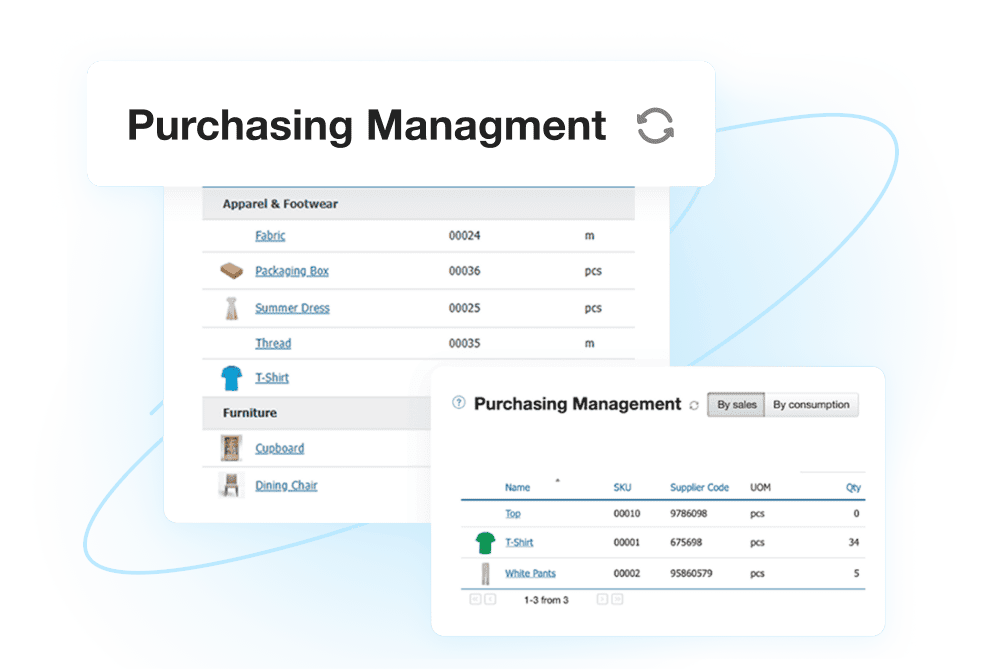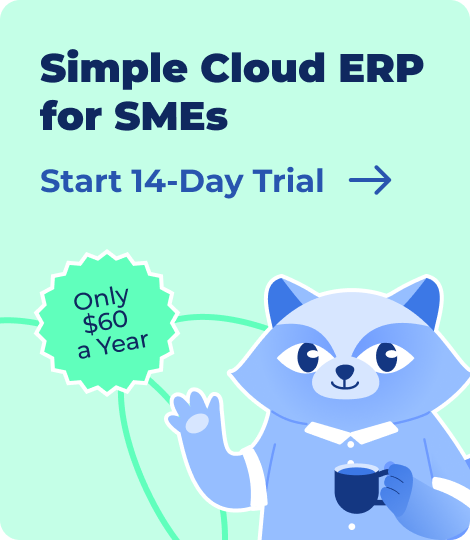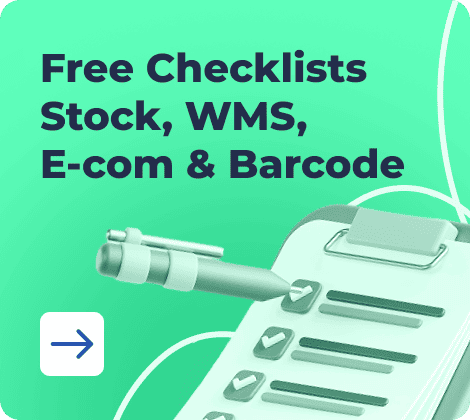Need a reliable way to manage your company’s purchases? A purchase order (PO) is more than a document, it’s a proof of what you agreed to buy, from whom, and under what conditions. A consistent purchase order template keeps your procurement process clear, protects your business from errors, and helps avoid disputes.
In this guide, you’ll find four free editable PO templates in Word, Excel, Google Docs, and Google Sheets. We’ll also explain how to fill them out, show examples for different industries, and share tips to prevent common mistakes. If you’re ready to move beyond spreadsheets, we’ll show you how an ERP system can automate the procurement processes.
- Download Free Purchase Order Templates
- What Is a Purchase Order and Why Use One?
- Types of Purchase Order Templates
- Kladana’s Free Basic PO Template
- How to Fill Out a Purchase Order Template: 8 Easy Steps
- Examples of Purchase Order Templates for Different Businesses
- Qualities of an Effective Purchase Order Template
- How to Send a Purchase Order to Suppliers
- PO Templates vs Manual Creation: What’s Better?
- How Kladana ERP Helps You Automate Purchase Orders
- Frequently Asked Questions on Purchase Order Templates
Download Free Purchase Order Templates
Choose the right format for your team:
- Excel PO Template — Best for businesses that track stock and pricing in spreadsheets
- Purchase Order Format in Word — Simple, printable format for smaller businesses
- PO template Google Sheets — Easy sharing and collaboration with vendors
- Google Docs PO Template — Clean, editable text version
| Format | Editable | Printable | Shareable | Best For |
| Excel | ✔ | ✔ | Limited | Inventory-heavy businesses |
| Word | ✔ | ✔ | Limited | Simple purchases & contracts |
| Google Sheets | ✔ | ✔ | ✔ | Remote teams & collaboration |
| Google Docs | ✔ | ✔ | ✔ | Service-based businesses |
🧊 4 Free Inventory Ckecklists
Learn how to manage stock, set up your warehouse, track barcodes, and build product cards for e‑commerce — even if you’ve never done it before
✅ Inventory management
✅ Warehouse setup
✅ Barcode tracking
✅ E-commerce product cards
What Is a Purchase Order and Why Use One?
A purchase order (PO) is a formal document a buyer sends to a supplier to request goods or services. It lists the items, quantities, prices, delivery dates, and payment terms. Once accepted, it becomes a legally binding agreement.
Using POs helps businesses:
- Prevent fraud — every order has an approved record.
- Control spending — managers can track commitments before money is spent.
- Avoid disputes — both sides agree on price, terms, and delivery.
- Maintain records — POs provide a paper trail for audits and tax compliance.
Purchase Order vs. Invoice vs. Quote
- Purchase Order (PO): Sent by the buyer to confirm an order.
- Invoice: Sent by the supplier to request payment for goods delivered.
- Quote: Sent by the supplier to propose prices before the order is placed.
A PO sits between a quote and an invoice. It signals intent to purchase and protects both buyer and supplier.
Types of Purchase Order Templates
Not all purchases are the same. Businesses use different types of purchase orders depending on frequency, volume, and terms. Choosing the right PO format makes the process smoother for both buyer and supplier.
Standard Purchase Order
The most common format. Used for one-time or irregular purchases.
📝 Example: A garment factory ordering 500 zippers from a supplier for the next production batch.
Blanket Purchase Order
Covers repeated purchases from the same supplier over time. It sets general terms but doesn’t fix exact quantities.
📝 Example: A construction company agreeing with a cement supplier on monthly deliveries at pre-negotiated rates.
Contract Purchase Order
Tied to a long-term supply agreement. Terms are fixed in the contract, and POs are issued against it.
📝 Example: An IT company signing a 1-year deal for software licenses and raising POs under that contract.
Scheduled Purchase Order
Used when deliveries are planned at specific times.
📝 Example: A food processing plant ordering packaging materials to be delivered in phases over six months.
Digital Purchase Order Template (for Cloud-Based Systems)
Generated and managed online through ERP software. Eliminates paperwork and human error.
📝 Example: An e-commerce brand using Kladana to auto-generate POs when stock drops below a set level.
Kladana’s Free Basic PO Template
To show how a purchase order works in practice, let’s look at Mr. Chopra, who owns Swordfish Exports, a mid-sized company that supplies fresh and frozen fish to international buyers. Instead of relying on phone calls and scattered emails, he uses Kladana’s free basic purchase order template to keep his procurement process clear.
Here’s how Mr. Chopra fills it out:
- Company Details — “Swordfish Exports Pvt Ltd” with GSTIN and registered address.
- PO Number & Date — PO-2078, issued on March 10, 2025.
- Supplier Details — “Blue Ocean Packaging” with contact info.
- Items Ordered — 2,000 insulated cartons, 5,000 ice gel packs, 200 export labels. Each line has SKU, unit price, and extended total.
- Delivery & Payment Terms — Delivery within 7 days; payment due in 30 days.
- Taxes & Total — GST added, final payable amount shown at the bottom.
👉 You can download the same free PO template Mr. Chopra used and adapt it for his own industry.
How to Fill Out a Purchase Order Template: 8 Easy Steps
Mr Chopra, the owner of fish exporting company Swordfish, is working with various suppliers. Over six months of work, he discovered that it’s hard for him to track all the orders they sent to suppliers. Sometimes it was hard for him to match an order with corresponding contract, to check prices or payment & shipment details.
So, he decided to use a unified template for all purchase orders Swordfish was issuing. Mr Chopra opted for Kladana free Google Sheets PO form. Let’s check out how he is working with a template. Follow short steps to make a personalized purchase order for your company.
Step 1. Make a Copy of the Template
Go to File menu → Make a copy → Rename the document the comfortable way
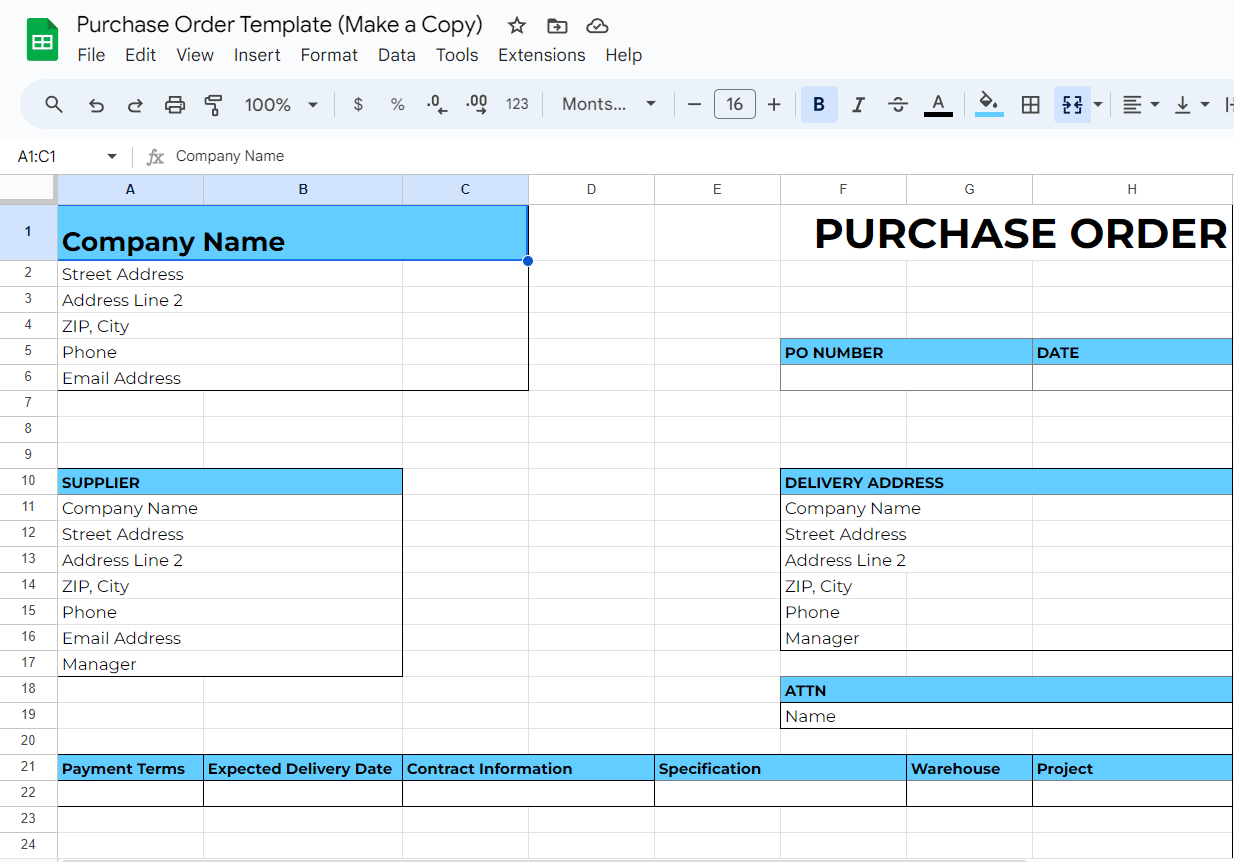
Step 2. Input Your Company Details
Carefully fill in the full address of your company, its email address, and a phone number.

Step 3. Assign PO number and date
Make sure to give a PO a unique combination of number and date to avoid confusion in the future. Consistent numbering and date indication will help you to keep your records on purchases in order.

Step 4. Fill in supplier info
Fill in the address and contact details of your counterparty.

Step 5. Enter shipping address and contact
If your company address corresponds to your shipping address, and you’re sure you won’t have new warehouses or other new shipment areas in the future, you may delete this section. In the ATTN section write down the name of the person in your company responsible for procurement/goods and services import.

Step 6. Specify delivery/payment terms
By specifying this information, you can always compare your orders with the corresponding contract, and check the prices and delivery conditions. In the Order field, you can indicate the order number or name if you use them for better identification and classification.

Step 7. List products with quantity, price, SKU
Before saving and sending your PO make sure that the formula used to calculate the amounts works correctly.

Step 8. Include taxes, discounts, and final total

Start creating your purchase orders in a convenient format. Download our free basic template in Word or Excel
Bonus
You can change and use the template for what you need. If you want to make your purchase processes easier and solve business tasks quicker and better, go to the last sheet of the form and try Kladana ERP.
📖 Recommended Read: Want to see how other businesses handle procurement and inventory challenges? Explore Kladana customer stories to learn how SMEs in manufacturing and trade use ERP to streamline purchasing and reduce errors.
You can also check our blog articles for step-by-step guides, free templates, and expert insights that help you run operations more efficiently.
Examples of Purchase Order Templates for Different Businesses
We have customized a basic PO template for the needs of different businesses to show you how to adjust the document to specify exactly those goods and services you need to procure
PO Template for Construction
Here is an example of PO that can be used in the sphere of construction and other businesses that procure materials and time-based services. This is what the core part of the template looks like:
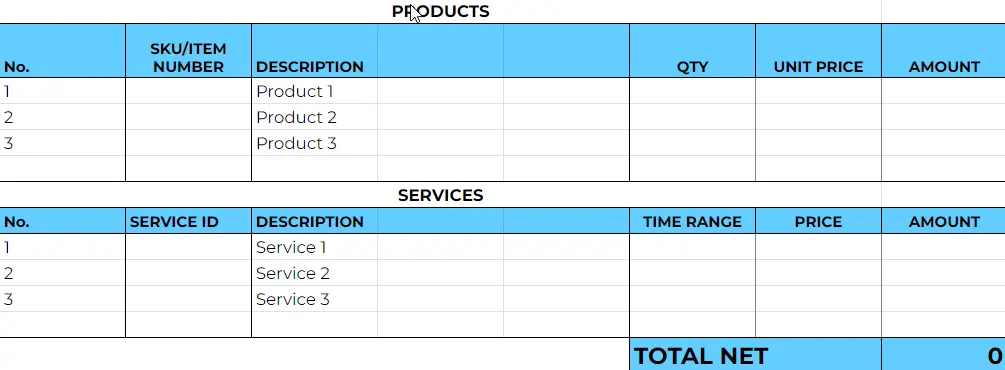
PO Template for Fabric Procurement
If you buy fabrics, you can specify the yarn type, choose the width of pieces of fabric, and add the information about finishing and dye type.

PO Template for Buying Garments
To keep your garment procurements in order and to avoid errors you can add columns for color or design details and sizes indication.

Qualities of an Effective Purchase Order Template
A good purchase order format should do more than just list items. It needs to be clear, complete, and easy to use across your team. A well-designed template reduces disputes, builds trust with suppliers, and saves time in audits. Check for the following qualities to evaluate the PO:
- Consistent Branding — Include your company name, logo, and contact details. This makes the document look professional and prevents confusion.
- Legal Validity — Each PO must have a unique number, date, supplier details, and complete terms. This ensures it stands as a binding document.
- Editable and Shareable — Teams should be able to adjust the template in Excel, Word, or Google Sheets without formatting issues.
- ERP Compatibility — Templates should be designed so they can be imported or mirrored in ERP systems for automation.
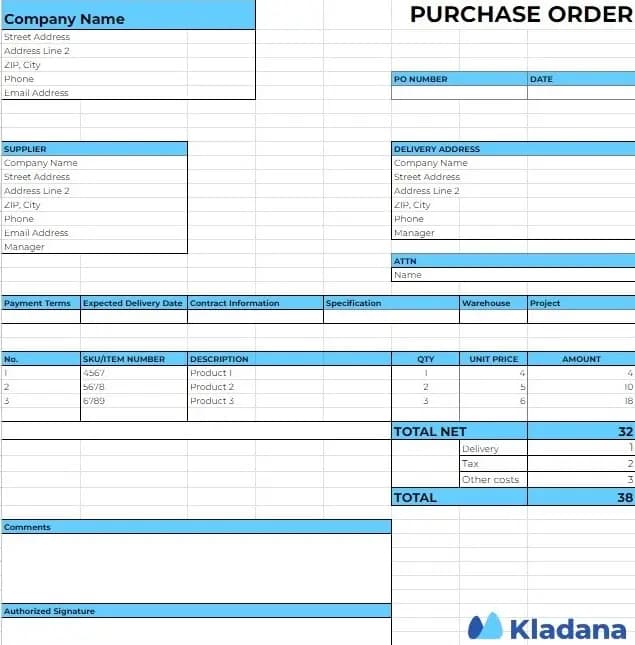
Good vs. Poor PO Design
| Feature | Good PO Template | Poor PO Template |
| PO Number & Date | Clearly visible | Missing or inconsistent |
| Supplier & Buyer Info | Full details | Only names, no contacts |
| Item List | Includes SKU, qty, unit price, tax | Only product names, no totals |
| Terms & Conditions | Delivery + payment terms included | Blank or vague |
| Layout | Easy to read, professional | Cluttered, inconsistent fonts |
How to Send a Purchase Order to Suppliers
Once your purchase order template is filled out, the next step is sending it to the supplier. The method depends on whether you’re the buyer or the vendor.
If You’re a Buyer
The safest approach is to email the PO as a PDF attachment. This keeps the formatting intact and prevents unauthorized changes. Always:
- Use a clear subject line like“Purchase Order PO-2025-014 — Swordfish Exports”.
- Attach the PO as a PDF.
- Add a short message confirming the order details.
If You’re a Vendor
Some buyers prefer editable POs, especially for service-based work. In this case, you can share a pre-filled Google Sheet or Google Doc. This allows for real-time updates and comments.
💡 Tip: Both Word and Google Docs let you export POs as PDFs. This ensures consistency when you need a fixed, non-editable version.
PO Templates vs Manual Creation: What’s Better?
Some businesses still create purchase orders manually in Word or Excel from scratch. While this works for a very small number of transactions, it can cause problems as your business grows.
Risks of Manual Creation
- Errors in totals — A single wrong formula can distort budgets.
- Inconsistent formats — Different employees may design POs differently, confusing suppliers.
- Time-consuming — Re-typing supplier details every time slows down procurement.
- Poor tracking — Hard to organize POs when each looks different.
Why Templates Are Better
- Ready-made structure — No need to design layouts or tables.
- Consistency — Every PO looks the same, reducing disputes.
- Faster turnaround — Fill in details instead of building from scratch.
- Scalable — Easy to adapt across multiple teams and locations.
💡 Best Practice: Start with free PO templates for Excel, Word, or Google Sheets. Once your order volume increases, move to ERP software where POs are generated automatically from sales or inventory data.
Already using our purchase order templates? Take the next step with more free tools.
Explore our collection of business templates — from invoice formats in Excel to a production schedule template and a bill book format PDF.
✔️ These resources help you keep documents consistent across finance, inventory, and operations.
How Kladana ERP Helps You Automate Purchase Orders
Templates are a good start, but as order volumes grow, even the best-designed spreadsheet becomes a bottleneck. That’s where Kladana ERP takes over. It turns your purchase orders into a fully automated workflow.
What Kladana Can Do
- Auto-generate POs — Create purchase orders directly from invoices, sales, or low-stock alerts.
- Supplier Data Autofill — Vendor names, GSTIN, and payment terms appear instantly without retyping.
- Track Approvals — Managers can approve or reject POs in real time.
- Monitor Deliveries — Match POs with goods received and flag delays.
- Take Processes under Control — Record operations, assign tasks, and manage the collaboration across the divisions involved
Set products, quantities, timing, and suppliers once — Kladana takes care of the rest. Automate purchasing rules and manage different procurement scenarios with ease.
Frequently Asked Questions on Purchase Order Templates
Businesses often have practical doubts about using and managing purchase orders. Here are clear answers to the most common questions:
What Is a Purchase Order?
A purchase order is a legally binding document issued by a buyer to a seller, indicating the type, quantity, and agreed-upon price of products or services. It serves as an official confirmation of the purchase and outlines the terms and conditions of the transaction.
How Does the Purchase Order Process Work?
Typically, the buyer initiates the process by creating a purchase order and sending it to the seller. Upon receiving the PO, the seller acknowledges the order, processes the request, and fulfills the delivery. The buyer then verifies the received goods or services against the details specified in the purchase order.
What Information Should Be Included in a Purchase Order?
A comprehensive purchase order should include essential details such as the item description, quantity, unit price, total cost, delivery date, payment terms, and any specific terms and conditions agreed upon by both parties. Accurate and complete information helps in avoiding discrepancies and disputes.
What’s the difference between a PO and an invoice?
A purchase order (PO) is created by the buyer to request goods or services from a supplier. An invoice is created by the supplier to request payment after goods or services are delivered. In short, the PO starts the transaction, while the invoice completes it.
Can I cancel or revise a PO?
Yes, but it depends on the supplier’s policies. If goods haven’t been shipped or produced yet, you can usually cancel or issue a revised PO. Once items are in transit, cancellation may not be possible. Always confirm with the vendor in writing.
Are PO templates legally valid?
Yes. A properly filled PO with buyer and supplier details, terms, and signatures (if required) is legally binding once accepted by the supplier. Using a standard purchase order template ensures all necessary fields are included.
Can I use a PO template with Excel or Sheets?
Absolutely. Аree purchase order templates in Excel and Google Sheets are popular for creating and managing POs. Templates help maintain a consistent format, and you can share Google Sheets with suppliers for real-time collaboration.
How do I integrate POs into my ERP?
Most ERP systems, including Kladana, allow you to import existing supplier details and automatically generate POs from stock levels or sales orders. This eliminates manual entry, reduces errors, and links your POs directly with inventory and payments.
Can These Templates Be Used with Different Software?
PO templates are often compatible with popular software like Microsoft Excel, Word, or Google Sheets. This ensures compatibility across various platforms, making it convenient for users regardless of their preferred software.
Do I Need Any Special Skills to Use These Templates?
No specialized skills are required. Purchase order templates are designed to be easy to use, even for those with limited experience in document creation. With a basic understanding of the procurement process, anyone can efficiently use these templates to generate professional-looking purchase orders.
Read‑alikes
Bill Of Materials (BOM): Definition, Examples, Format and Free Template
GST Invoice Template: download in Excel and Word Format
Invoice Templates for Excel: Free Download Format
How to Maintain Daily Stock in Excel — Download Free Template
Inventory Management in Excel: Free Template and a Step‑by‑Step Guide
